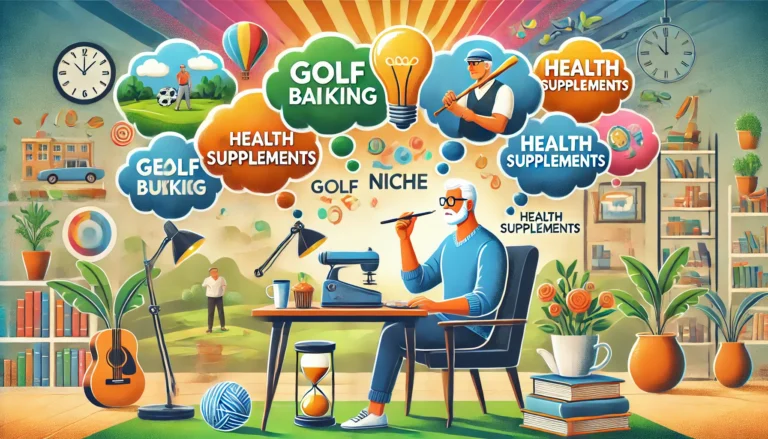How to Start Affiliate Marketing After 50
So here we are. You’ve hit 50 (or well past it—who’s counting?), and maybe you’re thinking: Is this it? The pension doesn’t quite stretch. You’ve still got that itch—no, not from the gardening gloves—an itch to do something meaningful, and maybe earn a little (or a lot) on the side.
This is where affiliate marketing struts in, like a friend you didn’t know you needed.
Why Bother With Affiliate Marketing? Isn’t That for Influencers and Kids on TikTok?
Yeah, kind of. But also—absolutely not.
Affiliate marketing is for anyone who can connect people with helpful stuff. That includes you. Especially you. You’ve lived through recessions, dial-up internet, and possibly Y2K panic. You’re not just some passive consumer—you’re a seasoned recommender, a trusted source (even if it’s just within your weekly walking group).
Besides, with tech now easier than assembling IKEA furniture (well, mostly), you don’t need a computer science degree. Just patience. Maybe some coffee. And a decent Wi-Fi signal.

Step One: What the Heck Are You Even Selling? (Pick Your Niche)
Don’t overthink this—at least not yet. Start with something you care about. Golf? Cool. Gluten-free baking? Even better. Retirement planning for ex-teachers? Hyper-specific—and potentially gold.
Remember: a niche isn’t just a topic. It’s a corner of the internet where people still have questions. And they want answers from someone who doesn’t sound like a 23-year-old hustle bro.
Personally, I went with wellness for men over 60 (because my uncle kept asking me about joint supplements). You’ll find your angle—just follow your curiosity.
Step Two: Find Stuff to Recommend (That Won’t Make You Feel Gross)
Yes, this is about money—but don’t sell your soul. There are tons of affiliate programs out there: Amazon (meh, low commission), ShareASale (solid), ClickBank (a little wild west, but okay), and even direct deals with companies.
Ask yourself: Would I use this? Would I tell my best friend about it over coffee? If not, maybe don’t.
Also, look for programs that actually pay on time. And pay well. Some offer recurring commissions—those are the unicorns.
Step Three: Build a Thing (Yes, a Website—but Calm Down)
This part trips people up. Don’t let it.
All you need is a simple blog. WordPress works. Pair it with Elementor or something else that doesn’t require a coder’s brain. Get a domain. Something like “FitAt55AndBeyond.com” or “SecondActSideHustle.net” (okay, maybe not that one—but you get it).
Blogs are still powerful. Social media is a bonus—not a foundation.
Pro tip? Start scrappy. Don’t aim for pixel perfection. Your audience cares more about clarity than design trends.

Step Four: Write Stuff People Actually Want to Read
Look, nobody wants robotic SEO gibberish.
Write like you’re explaining it to your neighbor. Or your cousin. Keep it useful, conversational, and yes—opinionated. Tell stories. Get vulnerable. Talk about the time you almost signed up for a scammy “crypto affiliate launch” but backed out because the sales page had too many exclamation marks.
Here’s what works:
- Lists: “7 Supplements That Helped My Knees Stop Screaming”
- Reviews: “I Tried 3 Meal Kits and Only One Didn’t Taste Like Cardboard”
- Comparisons: “Bluehost vs. SiteGround: Which One Won’t Make You Rage Quit?”
Also: sprinkle in affiliate links naturally. Don’t dump them all at the bottom like an afterthought..
Step Five: Spread the Word (Without Feeling Like a Used Car Salesperson)
So, you’ve written something—great. Now what?
Start small. Share it in Facebook groups (carefully—don’t spam), join forums, use Pinterest if that fits your niche (weirdly powerful), and yes, start an email list. Even if it’s just 10 people at first.
Offer a freebie. A checklist. A mini-guide. A one-page cheat sheet about the best travel backpacks for seniors with back issues. Whatever solves a tiny problem quickly.
One thing: SEO. It matters. But don’t obsess. Learn the basics—like putting your keyword in the title and not naming every image “IMG_2097.”
Step Six: Obsess a Little (But Not Too Much) About What’s Working
Okay, now you track. Check your blog analytics (Google Analytics, Plausible, whatever). Are people finding your stuff? Are they clicking? Buying?
You don’t need to become a data scientist—just pay attention. If one post’s getting all the traffic, write more like that. If a link never converts? Swap it.
Data is just feedback. It’s not judgment. Unless you’re ignoring it entirely—in which case, maybe a tiny bit of judgment.

What Most People Get Wrong (And Why You Might Too)
They try to be everywhere.
They write for algorithms, not people.
They expect results after two weeks.
Don’t.
Focus. Be human. Stick with it. You’ve had jobs, raised kids, paid mortgages. This? This is just a new chapter. A weird, sometimes-frustrating, often fun chapter.
Why Now? Why You?
Because—why not now?
We’re in 2025. People buy dog food through voice commands. The internet has room for everyone—especially someone who knows what it’s like to live through a power outage without checking Twitter.
You’ve got insights, compassion, and a filter for nonsense. That makes you the perfect guide in a noisy world.
So start. Messy. Imperfect. Confused. Start anyway.
Because affiliate marketing after 50 isn’t just a side hustle. It’s a statement. That you’re not done. That you still have things to say—and that you’re ready to say them loudly, proudly, and with a killer call-to-action link right beneath.
Now go write something. Then tell me how it goes. Or don’t. But at least give it a shot.




